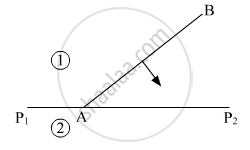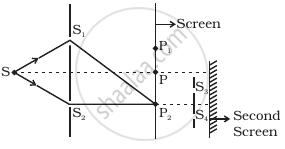Advertisements
Advertisements
Question
According to Huygens's principle, the amplitude of secondary wavelets is ______.
Options
equal in both the forward and the backward directions.
maximum in the forward direction and zero in the backward direction.
large in the forward direction and small in the backward direction.
small in the forward direction and large in the backward direction.
Solution
According to Huygens's principle, the amplitude of secondary wavelets is equal in both the forward and the backward directions.
Explanation:
- The Huygen principle states that every point on a wavefront serves as a source for secondary wavelets, whose amplitudes are proportional to those of the original wavefront. The secondary wavelets' amplitude, however, remains constant in all directions.
- Option (maximum in the forward direction and zero in the backward direction.) is not correct as the amplitude of the secondary wavelets is not zero in the backward direction.
- The amplitude of the secondary wavelets relies on the geometry and shape of the wavefront and may not be the same in all directions, therefore, options (large in the forward direction and small in the backward direction.) and (small in the forward direction and large in the backward direction.) are not necessarily true.
- So none of them is the exact answer for this, but the option (equal in both the forward and the backward directions.) could be correct either time.
RELATED QUESTIONS
What is the shape of the wavefront in the following case?
Light emerging out of a convex lens when a point source is placed at its focus.
You have learnt in the text how Huygens’ principle leads to the laws of reflection and refraction. Use the same principle to deduce directly that a point object placed in front of a plane mirror produces a virtual image whose distance from the mirror is equal to the object distance from the mirror.
Consider a plane wave front incident on a thin convex lens. Draw a proper diagram to show how the incident wave front traverses through the lens and after refraction focusses on the focal point of the lens, giving the shape of the emergent wave front.
Use Huygens’s principle to explain the formation of diffraction pattern due to a single slit illuminated by a monochromatic source of light.
Light waves travel in vacuum along the X-axis. Which of the following may represent the wave fronts?
With what type of source of light are cylindrical wave fronts associated?
Define a wavefront. Using 'Huygens' principle, draw the shape of a refracted wavefront, when a plane wave is incident on a convex lens.
Define the term 'wavefront of light'. A plane wavefront AB propagating from a denser medium (1) into a rarer medium (2) is incident of the surface P1P2 separating the two media as shown in fig.
Using Huygen's principle, draw the secondary wavelets and obtain the refracted wavefront in the diagram.

Figure shows a standard two slit arrangement with slits S1, S2, P1, P2 are the two minima points on either side of P (Figure). At P2 on the screen, there is a hole and behind P2 is a second 2-slit arrangement with slits S3, S4 and a second screen behind them.

Represent diagrammatically how the incident planar wavefronts of wavelength λ pass through an aperture of size d, when d is approximately equal to λ.
